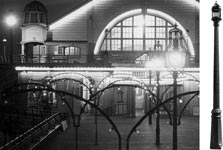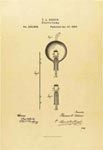|
CLOSE-UP:
 Taking a detailed look at Palmer’s original photograph ➄, it is possible to discern that the illumination of the pavilion was due as much to gas lamps on posts as to series of electric lamps. Though electric lighting was familiar to him since the time he was born, Duchamp must have found the serial use of lit bulbs for the pavilion especially festive and sensational. It amply decorated the pavilion’s façade, running along the fringes of its two-slopped roof, the arched periphery of its dominant lunette, and horizontally straight across its first floor. It also provided a canopy of lamps on the court connecting the pavilion to the theatre through a decorative scheme of three rows of pairs of double arches that run along the length of the pier, and terminate closer to the viewpoint into a triple arch that seems to be in progress, as some of its sparse light bulbs are yet to be supplied with electricity. Taking a detailed look at Palmer’s original photograph ➄, it is possible to discern that the illumination of the pavilion was due as much to gas lamps on posts as to series of electric lamps. Though electric lighting was familiar to him since the time he was born, Duchamp must have found the serial use of lit bulbs for the pavilion especially festive and sensational. It amply decorated the pavilion’s façade, running along the fringes of its two-slopped roof, the arched periphery of its dominant lunette, and horizontally straight across its first floor. It also provided a canopy of lamps on the court connecting the pavilion to the theatre through a decorative scheme of three rows of pairs of double arches that run along the length of the pier, and terminate closer to the viewpoint into a triple arch that seems to be in progress, as some of its sparse light bulbs are yet to be supplied with electricity.
ILLUMINATING THE NIGHT:
 Gas was the most popular means of lighting in cities before electricity became sufficiently widespread and economical enough to allow for general public use in the late 19th century. As a matter of fact, surviving gas lampposts at Herne Bay ➅ suggest that this technology was widely practiced and persisted well into the 20th century. The electric lighting itself has a fascinating history before it succeeded gaslight. The concept of carbon-arc lighting was first demonstrated by Sir Humphry Davy in 1808. In 1841 Frederick de Moleyns of England was granted the first patent for an incandescent lamp using powdered charcoal heated between two platinum wires contained within a vacuum bulb. It is worth noting, however, that on 27 January 1880 Thomas Edison received the historic patent ➆ that embodies the principles of his improved incandescent lamp, which paved the way for the universal domestic use of electric light. Using a carbonised bamboo filament, his lamp could practically last over 1,200 hours, thus enabling Edison to become the first to market this device successfully. On 27 November 1880, Joseph Swan obtained British Patent for a light bulb that was viable enough to begin installing it in homes and landmarks in England, and subsequently started his own company that merged with Edison’s in 1883 to be commonly known as “Ediswan.” In 1906, the General Electric Company patented a revolutionary method of making tungsten filaments that outlasted all previous types and made the costs affordable. The tungsten technology itself improved over time, and it was such bulbs that were used alongside gaslight for the illumination of Herne Bay’s Grand Pavilion. Duchamp was a boarder at the Lycée Pierre Corneill in Rouen, the capital of Normandy, between 1897 and 1904, when he encountered all the electricity-related inventions that were blossoming at the end of the 19th century – lighting and cinematography. Gas was the most popular means of lighting in cities before electricity became sufficiently widespread and economical enough to allow for general public use in the late 19th century. As a matter of fact, surviving gas lampposts at Herne Bay ➅ suggest that this technology was widely practiced and persisted well into the 20th century. The electric lighting itself has a fascinating history before it succeeded gaslight. The concept of carbon-arc lighting was first demonstrated by Sir Humphry Davy in 1808. In 1841 Frederick de Moleyns of England was granted the first patent for an incandescent lamp using powdered charcoal heated between two platinum wires contained within a vacuum bulb. It is worth noting, however, that on 27 January 1880 Thomas Edison received the historic patent ➆ that embodies the principles of his improved incandescent lamp, which paved the way for the universal domestic use of electric light. Using a carbonised bamboo filament, his lamp could practically last over 1,200 hours, thus enabling Edison to become the first to market this device successfully. On 27 November 1880, Joseph Swan obtained British Patent for a light bulb that was viable enough to begin installing it in homes and landmarks in England, and subsequently started his own company that merged with Edison’s in 1883 to be commonly known as “Ediswan.” In 1906, the General Electric Company patented a revolutionary method of making tungsten filaments that outlasted all previous types and made the costs affordable. The tungsten technology itself improved over time, and it was such bulbs that were used alongside gaslight for the illumination of Herne Bay’s Grand Pavilion. Duchamp was a boarder at the Lycée Pierre Corneill in Rouen, the capital of Normandy, between 1897 and 1904, when he encountered all the electricity-related inventions that were blossoming at the end of the 19th century – lighting and cinematography.
|

